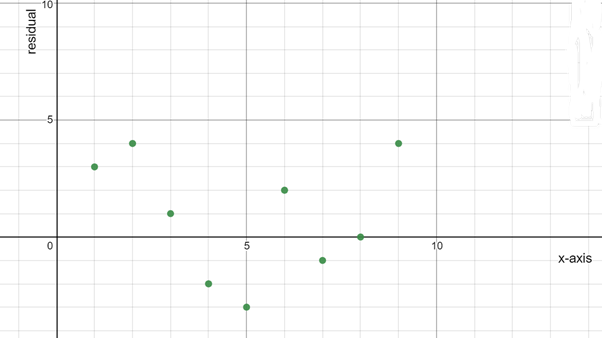
Concept explainers
To determine whether the model is a good fit for the data in the table −

Answer to Problem 6E
The model isa good fit for the data in the table.
Explanation of Solution
Given:

Formula Used:
A residual is a measure of how well a line fits an individual data point. This vertical distance is known as a residual. For data points above the line, the residual is positive, and for data points below the line, the residual is negative. The closer a data point's residual is to
Calculation:
| Residual | |||
Plotting the above points on the graph, we have:

From the above graph, we can see that the residuals form a straight line.
Thus, the model isa good fit for the data in the table.
Conclusion:
The model is a good fit for the data in the table.
Chapter 4 Solutions
BIG IDEAS MATH Integrated Math 1: Student Edition 2016
- Find the Soultion to the following dy differential equation using Fourier in transforms: = , хуо, ухо according to the terms: lim u(x,y) = 0 x18 lim 4x (x,y) = 0 x14 2 u (x, 0) = =\u(o,y) = -y لوarrow_forward. Expand sinh z in Taylor's series at zo = πi, and show that lim sinh: καπί κ - п - - 1.arrow_forwardQ prove or disprove: If Ely/x) = x = c(dipy =BCCo (BVC) ECxly)=y, and E(X2), Ely)arrow_forward24.3. Show that 8 (a). =(+1)(z+1)*, |+1|<1, j=0 8 (b). sin³ z j=0 (-1) 3(1-9) 4 (2j+1)! 22j+1, |<∞,arrow_forward24.4. For the function g(z) defined in (18.7), show that g(z) = j=0 z2j (−1)³ (2j+1)!" Hence, deduce that the function g(z) is entire. 2 E C.arrow_forwardCan you solve question 3,4,5 and 6 for this questionarrow_forwardwater at a rate of 2 m³/min. of the water height in this tank? 16) A box with a square base and an open top must have a volume of 256 cubic inches. Find the dimensions of the box that will minimize the amount of material used (the surface area). 17) A farmer wishes toarrow_forward#14 Sand pours from a chute and forms a conical pile whose height is always equal to its base diameter. The height o the pile increases at a rate of 5 feet/hour. Find the rate of change of the volume of the sand in the conical pile when the height of the pile is 4 feet.arrow_forward(d)(65in(x)-5 cos(x) dx mins by 5x-2x² 3x+1 dx -dx 20 Evaluate each the following indefinite integralsarrow_forward19 Evaluate each the following definite integrals: a) લ b) (+3) 6) (2-2)(+33) dxarrow_forward#11 If a snowball melts so its surface area decreases at a rate of 1cm²/min, find the rate at which the diameter decreases when the diameter is 6 cm.arrow_forwardUse Deritivitve of the inverse to solve thisarrow_forwardarrow_back_iosSEE MORE QUESTIONSarrow_forward_ios
 Discrete Mathematics and Its Applications ( 8th I...MathISBN:9781259676512Author:Kenneth H RosenPublisher:McGraw-Hill Education
Discrete Mathematics and Its Applications ( 8th I...MathISBN:9781259676512Author:Kenneth H RosenPublisher:McGraw-Hill Education Mathematics for Elementary Teachers with Activiti...MathISBN:9780134392790Author:Beckmann, SybillaPublisher:PEARSON
Mathematics for Elementary Teachers with Activiti...MathISBN:9780134392790Author:Beckmann, SybillaPublisher:PEARSON
 Thinking Mathematically (7th Edition)MathISBN:9780134683713Author:Robert F. BlitzerPublisher:PEARSON
Thinking Mathematically (7th Edition)MathISBN:9780134683713Author:Robert F. BlitzerPublisher:PEARSON Discrete Mathematics With ApplicationsMathISBN:9781337694193Author:EPP, Susanna S.Publisher:Cengage Learning,
Discrete Mathematics With ApplicationsMathISBN:9781337694193Author:EPP, Susanna S.Publisher:Cengage Learning, Pathways To Math Literacy (looseleaf)MathISBN:9781259985607Author:David Sobecki Professor, Brian A. MercerPublisher:McGraw-Hill Education
Pathways To Math Literacy (looseleaf)MathISBN:9781259985607Author:David Sobecki Professor, Brian A. MercerPublisher:McGraw-Hill Education





